Beggars and Artisans: A Cultural History of Cork’s Franciscan Friary / Styles and Stained Glass in St Francis Church
- Elaine Harrington
- May 27, 2021
Student Exhibition, MA in Medieval History
Beggars and Artisans: Styles and Stained Glass
Architecture and iconography of the modern St Francis Church in Cork merge various medieval stylistic traditions, ranging from eastern Byzantine elements to western Gothic influences, which together are suggestive of the geographical spread of the Franciscan Order.
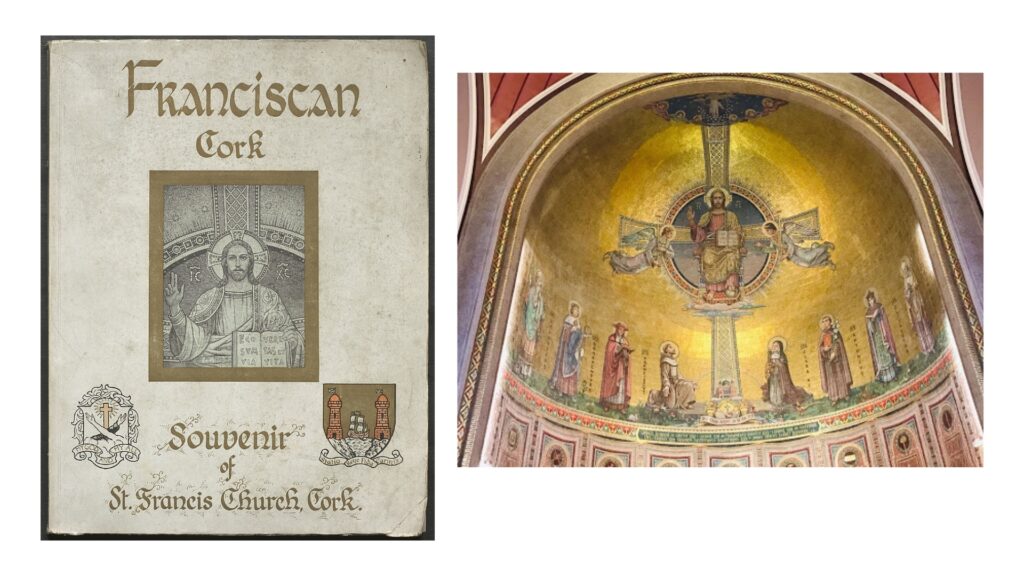
Right: Christ in Majesty. Apse mosaic, St Francis Church, Cork. Photo: Małgorzata Krasnodębska-D’Aughton.
The church’s main apse mosaic presents a magnificent image of Christ in Majesty. The overall composition of Christ enthroned, surrounded by angels and accompanied by saints, draws heavily from artistic traditions of the early Christian apsidal mosaics. The dominant use of gold in the image is evocative of early Christian and Byzantine art. Father Jerome O’Callaghan, OFM, noted that the church has many Byzantine features in its mosaics, floor design and sculptural details. For example, Greek letters are incorporated within the apse mosaic, column capitals and the terrazzo flooring by the front doors. The letters IC XC that flank the head of Christ in the apse, represent a Christogram or a sacred monogram of Christ and stand for the abbreviated Greek words: Jesus Christ. The letters Alpha (Α) and Omega (ω) carved on capitals are the first and last letters of the Greek alphabet; in the Christian tradition they came to signify Christ as the beginning and the end of things, evoked in the Book of the Revelation 1:8.
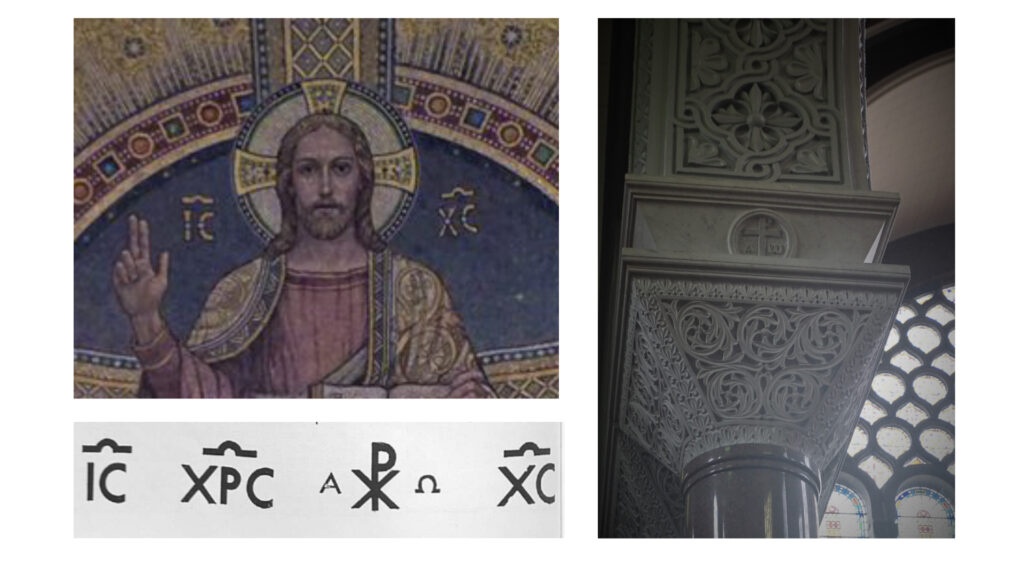
Lower left: Examples of Christograms recorded by Father Jerome O’Callaghan in Franciscan Cork: Souvenir of St. Francis Church, Cork (1953). Special Collections, UCC Library.
Right: The Alpha and Omega letters, column capital, St Francis Church, Cork. Photo: Małgorzata Krasnodębska-D’Aughton.
Western medieval inspirations are seen in stained-glass windows that comprise a series of figurative windows placed in a transept as well as a large window in the façade, which consists of seven round-headed lights under the tracery. Four figurative windows are situated at either side of the central apse in the transept arms. Each window is round-headed with double lights. These transept windows depict eight figures: in the left transept we see the pairings of St Elizabeth of Hungary and St Bernardine of Siena, and St Francis of Assisi and Christ (Sacred Heart of Christ), in the right transept there are the Virgin Mary and St Joseph, and St Paschal and St Louis IX.


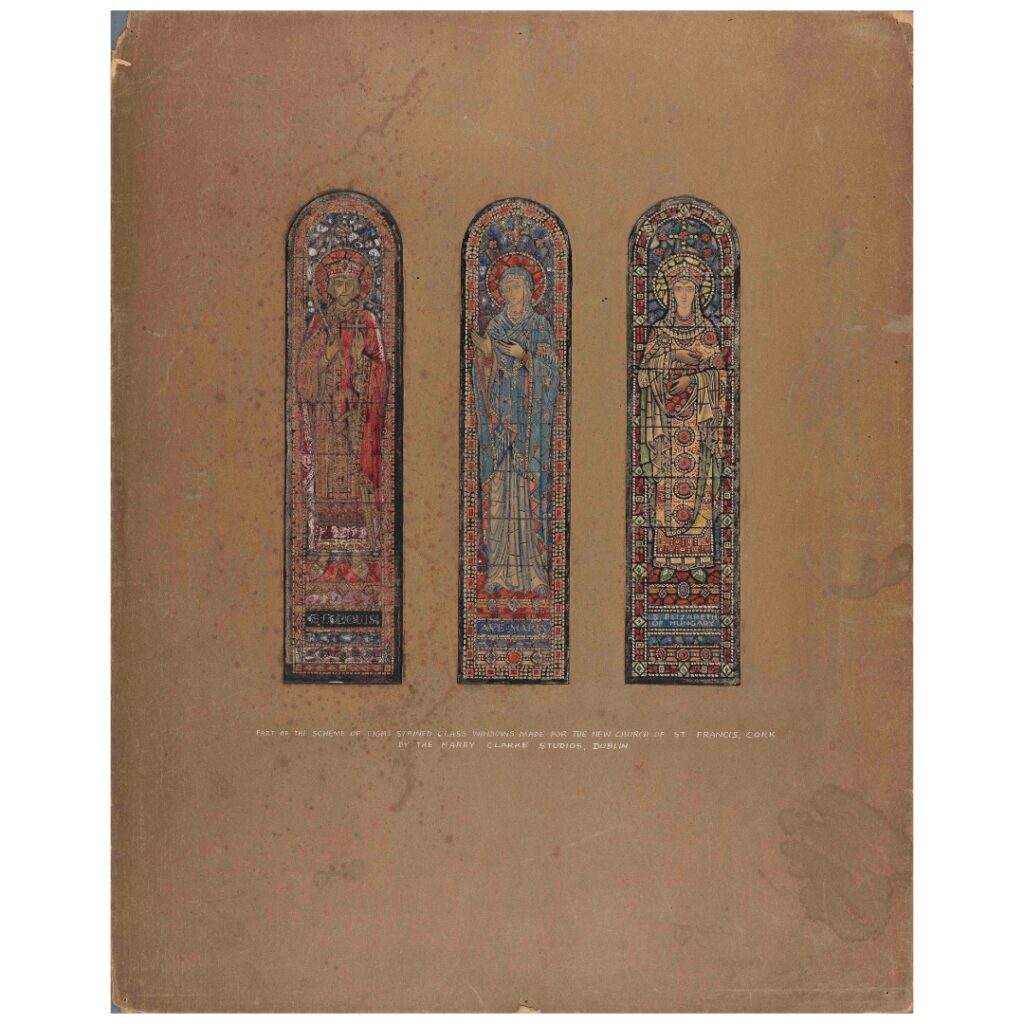
The stained-glass windows in Cork’s St Francis Church were designed by the Harry Clarke Studios situated on North Frederick Street in Dublin. Harry Clarke (1889-1931) was a renowned stained-glass artist, who started by working for his father Joshua Clarke (d. 1921), a builder and glassworker, before studying his craft at the Dublin Metropolitan School of Art. During his career, Harry designed many windows to great acclaim, including multiple windows in the churches of Cork, such as the Honan Chapel and the Holy Trinity Church. Plagued with ill health, Harry Clarke died in 1931, but his studios continued to produce commissions until 1973.
The preparatory sketches from the Harry Clarke Studios show how St Francis Church stained-glass windows took shape and the importance of both the content of images and the precision required in moving the plans from paper to glass.
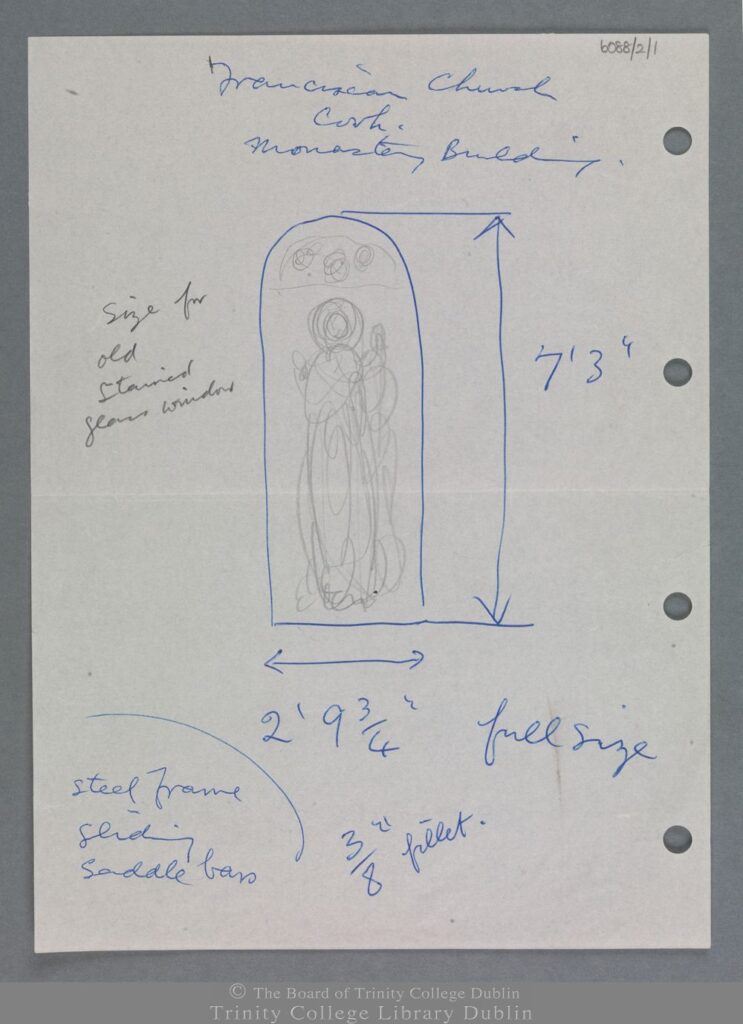
A letter addressed to Reverend Father Gerald, that dates from 23 October 1956, gives an insight into the collaboration between the friars and the Studio in choosing the imagery for the new church.
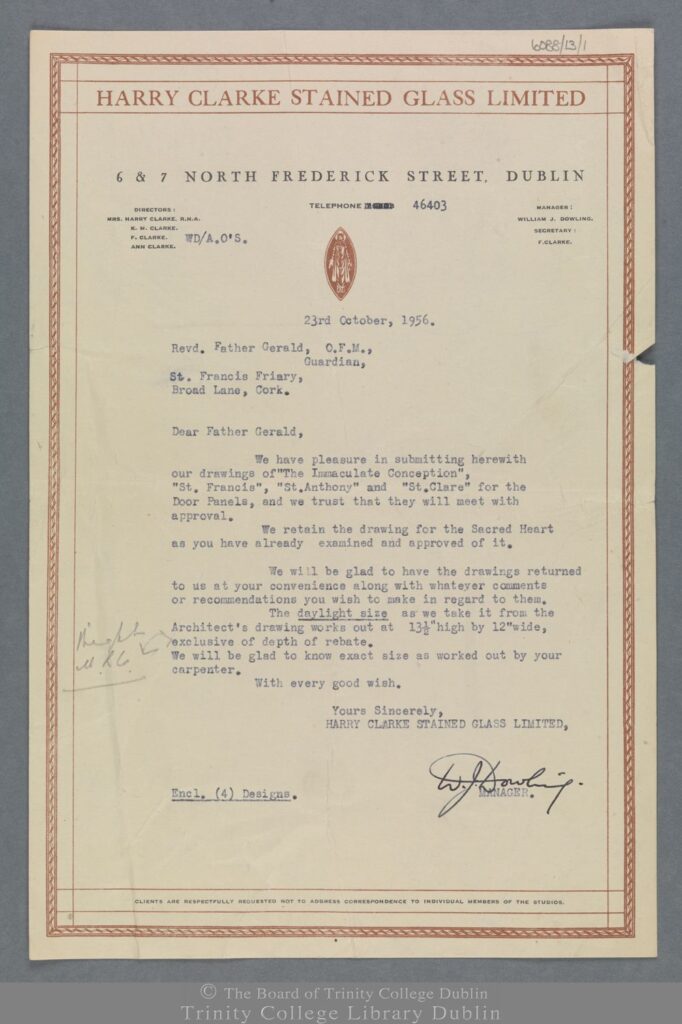
Further letters from the building contractors M.L. Cowman and Sons to the Harry Clarke Studios illustrate the necessity for correct measurements, not only for the windows but also other glass panelling in St Francis Church.
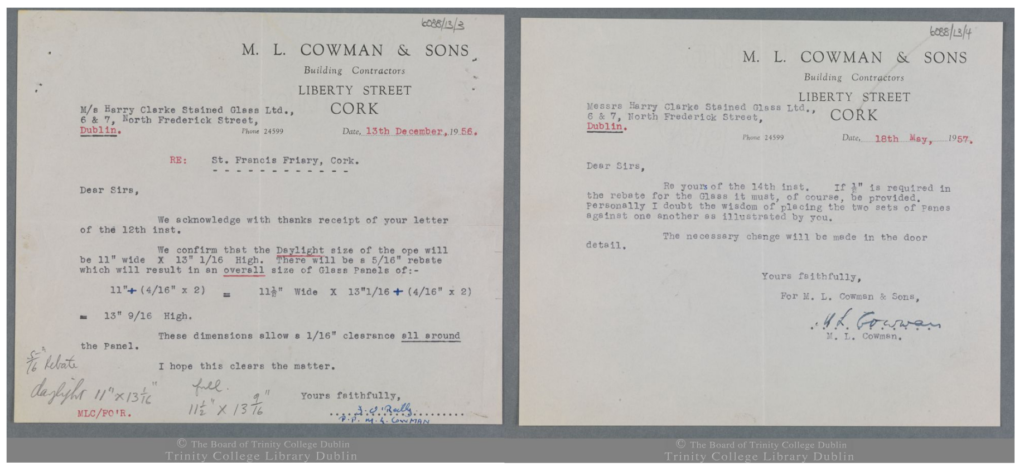

Photograph: Elaine Harrington
The planning stage of church glazing is not always a straightforward process as seen in the case of the Capuchin friary of the Holy Trinity in Cork. A memorial window was commissioned for Father Thomas Dowling by the Cork District Trades and Labour Council in recognition of his work in setting up the first Conciliation Board in Cork in 1919, to mediate disputes between trade unions and employers. Harry Clarke was the chief designer on the project, but problems arose in the planning stage concerning the Council’s insistence on having a large inscription in the window. Clarke felt that the inscription would detract from the window’s artistic integrity and could not be read easily from the ground. The situation worsened, when it emerged that there had been a mistake in window measurements, and he demanded to be paid for the extra work he incurred as a result of delays. The issue was eventually resolved when Joshua Clarke offered to finish the commission, while using Harry’s original design.
The saints included in the windows and the apse mosaic of St Francis Church act as visual expressions of Franciscan identity, so that viewers can be inspired by their exemplary lives and learn about the history of the Franciscan Order.
St Francis of Assisi (1181/82-1226), the founder of the Franciscan Order, is pictured in the stained-glass window holding up his hands to display the stigmata on his hands and feet. Two doves are included in the image reminding the viewer of the Saint’s affinity with animals. In the same window, Christ displays the wounds on his hands and feet, and his heart shines brightly from inside his scarlet robes. The design of the window strikingly highlights the connection between Francis and Christ, and the two images express a theme of Francis as the Other Christ.
St Bernadine of Siena (1380-1444) was an Italian Franciscan most well-known for his expressive preaching. He is pictured in the window holding the Holy Name monogram, which he used in preaching missions to promote this devotion. To his left stands a striking figure of St Elizabeth of Hungary (1207-1231) wearing a Byzantine style headdress and colourful garments. Elizabeth was the daughter of King Andrew II of Hungary and married Louis IV of Thuringia at the age of fourteen. Elizabeth devoted her life to looking after the poor and the sick, building a hospital at the foot of Wartburg Castle, where she personally nursed the infirm. After her husband’s death on route to the Sixth Crusade, she joined the Third Order of the Franciscans and built another hospital in Marburg in Hesse dedicated to St Francis. She is often represented giving food to the poor as on the print from the Metropolitan Museum of Art.
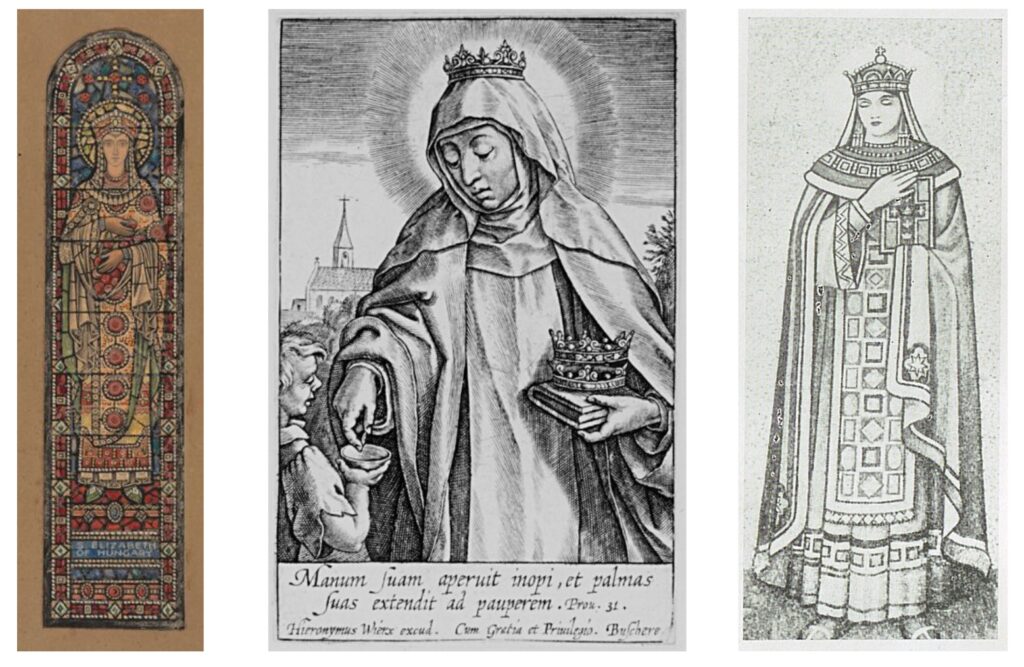
Centre: St Elizabeth of Hungary by Hieronymus (Jerome) Wierix. The Elisha Whittelsey Collection, The Metropolitan Museum of Art.
Right: Drawing of a mosaic depicting St Elizabeth of Hungary in the main apse, St Francis Church, Cork, reproduced in Franciscan Cork: Souvenir of St. Francis Church, Cork (1953), 69, Special Collections, UCC Library.
The right transept windows represent St Paschal Baylon and St Louis IX, King of France. St Paschal Baylon (1540-1592) was a Spanish Franciscan lay brother, who was admired for his strict observance of the Rule of Francis and devotion to the Eucharist. He was sent by his superior to France to defend the Eucharistic doctrine in a debate with a Calvinist preacher. As a result, he was chased and almost killed by an angry mob.
St Louis IX (1214-1270) was the King of France from 1226 to 1270, and was involved in two crusades, dying in Tunisia. He was a patron of the mendicant orders and displayed a strong devotion to the Passion of Christ. He is depicted in the window holding a crucifix, a sceptre and a sword, signs of his royal authority and devotions.
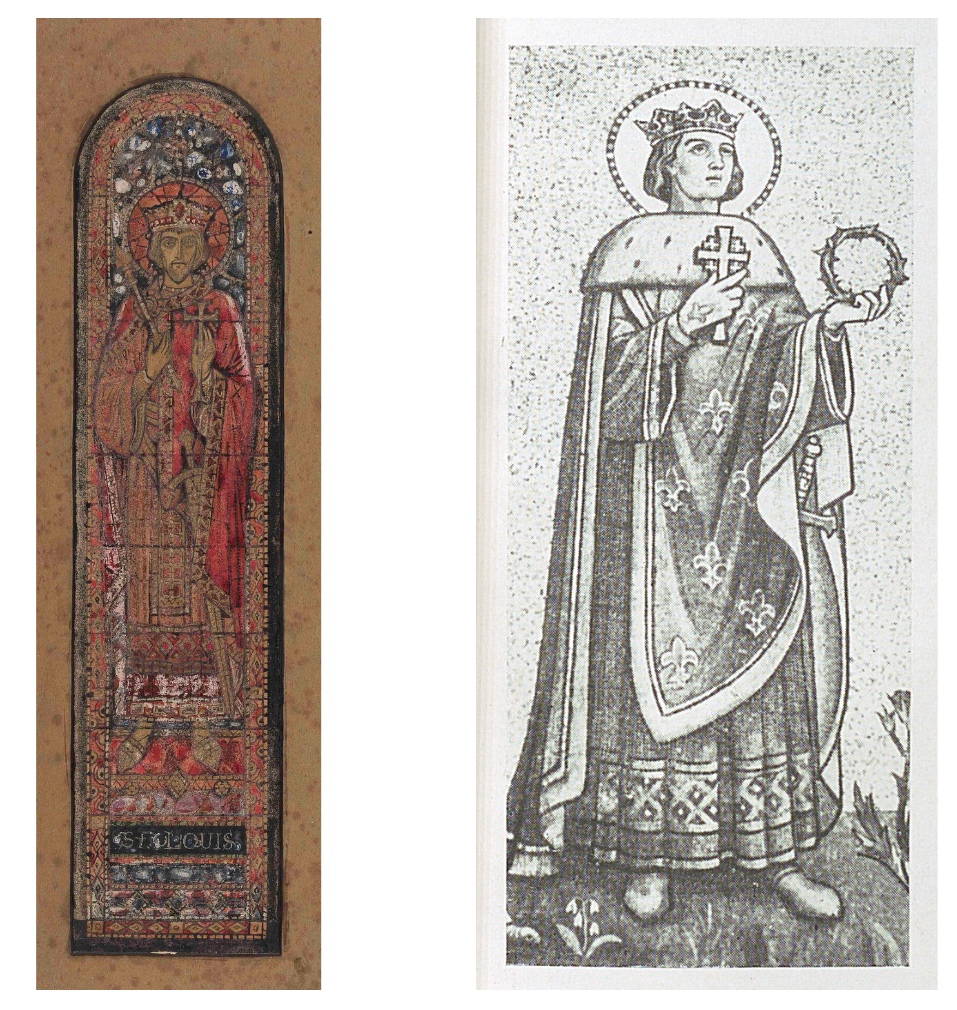
Right: Drawing of the mosaic depiction of St Louis, King of France in the main apse, St Francis Church, Cork. St Louis IX is shown holding a cross and a crown of thorns, the relics of which he purchased in Constantinople. These relics were housed in Sainte Chapelle. Image from Franciscan Cork: Souvenir of St. Francis Church, Cork (1953), 69, Special Collections, UCC Library.
The remaining figures in the windows represent Mary and Joseph. The Virgin Mary is shown with outstretched hands, wearing her signature blue garments. St Joseph occupies the space to her right wearing green robes and holding a lily, which is considered as his emblem.

The tradition of using stained-glass windows in Franciscan churches goes back to the medieval times, when splendid visual schemes were executed in glass in the great churches of the Order such as the Basilica of St Francis in Assisi and Santa Croce in Florence. Franciscan writers, including Bonaventure (1217-1274) believed that stained-glass windows with their transparency and coloured luminosity, could help with contemplation and devotion, because as he stated through the corporal light ‘we are thoroughly led to understand even the spiritual.’
Martha Ewence
Further reading
Curtin-Kelly, Patricia, An Ornament to the City: Holy Trinity Church and the Capuchin Order (Dublin, 2015).
Dunne, Aidan, ‘A Colourful Window into Harry Clarke’s World’, Irish Times, 3 March 2018.
Frazier, Adrian, ‘Harry Clarke and the Material Culture of Modern Ireland’, Textual Practise 16 (2002, online edition).
McKee, Ruth, ‘God is in the Detail: Harry Clarke’s Stained Glass’, Irish Times, 27 June 2020.
Ó Clabaigh, Colmán, ‘The Other Christ: The Cult of St Francis of Assisi in Late Medieval Ireland,’ in Rachel Moss, Colmán Ó Clabaigh, and Salvador Ryan, eds, Art and Devotion in Late Medieval Ireland (Dublin, 2006), 142-162.
O’Callaghan, Jerome, Franciscan Cork: A Souvenir of St. Francis Church Cork (Killiney, 1953).
Pieper, Lori, The Voice of a Medieval Woman: St Elizabeth of Hungary as a Franciscan Penitent in the Early Sources for Her Life (New York, 2016).
Spieser, J.M., ‘The Representation of Christ in the Apses of Early Christian Churches’, Gesta 37, no. 1 (1998), 63-73.
- Architecture
- Beggars and Artisans
- Cork
- Cork's Franciscan Friary
- Franciscan order
- Franciscans
- Harry Clarke
- Harry Clarke Studios
- Honan Chapel
- MA in Medieval History
- medieval Cork
- Munster Printing Collection
- School of History
- special collections
- St Francis Church in Cork
- St Francis of Assisi
- stained glass
- student engagement
- student exhibition
